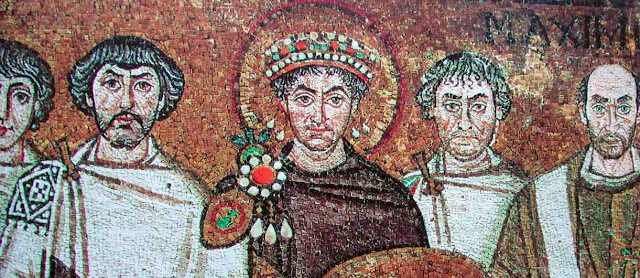- Justinian and the Corpus Iuris Civilis
Flavius Anicius Justinianus, born in what is now Serbia, of Slav parents, came to the throne in A.D. 527. At that date the law of the Empire consisted of: ius vetus (the old law), which included those leges of the Republic and early Empire which had not fallen into disuse, senatusconsulta, and a large number of juristic writings of former epochs, and ius novum (the new law), which consisted of numerous Imperial Constitutions. Justinian immediately commenced an extensive process of legal reform which culminated in the massive Corpus Iuris Civilis, consisting of:
+ Codex Vetus.
+ Digesta, or Pandectae.
+ Quinquaginta Decisiones.
+ Institutiones.
+ Codex Repetitae Praelectionis.
+ Novellae Constitutiones.
- Codex Vetus (The Old Code) A.D. 529
A commission of ten ministers of state, two leading advocates and Theophilus, a professor at Constantinople, was appointed to consolidate the Imperial Constitutions by scrapping those which had fallen into disuse and those which were considered to be irrelevant. Those constitutions of relevance were to be summarised. The work (Justinianeus Codex, or Codex Vetus) was completed in just over one year and was ratified in A.D. 529. The Codex consisted of 12 books.
- Digesta, or Pandectae, A.D. 533
+ In A.D. 530 Justinian appointed Tribonian, an eminent jurist (who had been a member of the commission responsible for the Codex Vetus) to head a commission of sixteen, made up of professors of the law and members of the bar. Their task was to study the writings of the great jurists who had been given ius respondendi. They were to extract from the writings that which was valuable and they were to scrap any repetition or contradictions. They were allowed to adapt the jurist's language so that if was relevant to the law of Justinian's time. The result of their work was to be published in 50 books, arranged in titles.
+ The work, for which ten years had been allowed, was completed in three years. The writings of 39 jurists, totalling three million lines, were reduced to 150,000 lines, consisting of 9,123 extracts. The arrangement followed the general order of the Edictum Perpetuum of Julianus and may have reflected the work of three separate sub-committees which examined in particular:
. Ulpian's commentaries on Sabinus and associated writers;
. Writings on the Edict;
. The works of Papinian and associated writers.
+ The Digest was published in December, A.D. 533. Commentaries on it were forbidden.
- Quinquaginta Decisiones, A.D. 529-532
Prior to the commencement of work on the Digest, and during its compilation, a number of problems of interpretation arose. By enacting a series of constitutiones, Justinian settled these controversies. The enactments became known as "The Fifty Decisions".
- Institutiones (The Institutes), A.D. 533
Tribonian, Dorotheus (professor of law at Beirut) and Theophilus were entrusted with the compilation of a legal textbook for students, to be based on the Institutes of Gaius. The compilers were instructed to eliminate from Gaius that which was obsolete and to do whatever was neccessary to produce a useful, elementary treatise of the law. The Institutes, divided into four books, were published in November, A.D. 533 and their arrangement follows that used by Gaius in his Institutes.
Note: Gaius (his full name is unknown) lived between A.D. 130-180. He may have been a professor of law at Troas, in Asia. His writings included the Institutes, a commentary on the XII Tables and a treatise on the Edicts of the Magistrates. He may have belonged to the Sabinian school, and was one of the five jurists whose writings were recognised as authoritative by the Law of Citations. The Digest contains 535 extracts from his works.
- Codex Repetitae Praelectionis, A.D. 534
A commission of four (Dorotheus and three advocates) was appointed, under the supervision of Tribonian, to incorporate the Quinquaginta Decisiones with a new edition of the Codex Vetus. The revised Codex was promulgated in A.D. 534; its preface was a constitution (Cordi Nobis) which gave it authority. It consists of 12 books of 4,652 constitutiones dating from the time of Hadrian.
- Novellae Constitutiones post Codicem (Enactments, or Novels, subsequent to the publication of the Code)
About 165 constitutiones enacted after the Codex Repetitae Praelectionis, between A.D. 534-565, are preserved. Most relate to ecclesiastical and public matters; some deal with important reforms in the law of intestate succession.
----------
- The codification of Roman Law
+ The codification of Roman Law (I): The Twelve Tables
+ The codification of Roman Law (II): Other codification prior to Justinian
----------
Source:
Roman Law, L. B. Curzon, pages 24 - 26.
